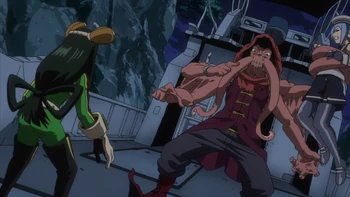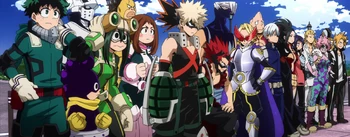My Hero Academia, Season 2, Part 2
 So a while back I reviewed the first part of My Hero Academia's second season. Took a bit of a break, and then I sort of marathoned the rest of season 2 and the rest of season 3 in a couple of sittings and... and it ended up taking a while before I got the energy to really talk about the season. It's around this time when I reviewed the manga pretty regularly, too, which ended up with a huge sense of writer's block when figuring out what to talk about.
So a while back I reviewed the first part of My Hero Academia's second season. Took a bit of a break, and then I sort of marathoned the rest of season 2 and the rest of season 3 in a couple of sittings and... and it ended up taking a while before I got the energy to really talk about the season. It's around this time when I reviewed the manga pretty regularly, too, which ended up with a huge sense of writer's block when figuring out what to talk about.
I guess I'll keep this relatively short -- my feelings about the whole Stain/Hero Killer arc, running for 8 episodes from episode 26 to 33, is still more or less the same. Part of the plot does hinge on extreme coincidence, and that bit is far more prominent when I'm binge-watching the episodes instead of reading it weekly. The fact that Iida encounters Stain right after Stain has an argument with Shigaraki, and that both Midoriya (someone that fits Stain's criteria to boot) and Todoroki's respective internship teams are actually around in the area, ready to lend some help, feels like a huge chunk of contrived coincidence.
Despite all this, though, I am really impressed at the amount of character focus Iida primarily has in the Hero Killer arc. Stain himself has always been a favourite of mine, this... this bizarre character with such strong convictions, as twisted as his methods and logic are, is made far, far more compelling with the amazing voice talent of Go Inoue. The animation in the Stain segments are also pretty damn top-notch! I won't really go into detail in deconstructing Stain's ideology and the like -- I believe that it's actually intentionally controversial, equal parts well-meaning extremist and something that the villains are able to twist to their ends.
Shigaraki does end up feeling a fair bit more petulant than I remembered him being, although that, again, is part of his voice actor's pretty neat work. I think my mental voice for Shigaraki while I was reading his original manga lines made him sound more deranged and maniacal, whereas here it's definitely intended for Shigaraki just to be a spiteful little shit who only cares about the short-term.
 Far more improved in the anime version are the actual scenes of the 1A/1B students' internship, something that literally flew over my head in the manga. Again, part of it is thanks to the incredible voice acting for both students and their mentors, but also because the scenes are actually noticeably extended a bit more to let them sink in. We also get a huge chunk of episode 32, "Everyone's Internships", to compile the various scattered scenes in the manga and have a full, light-hearted episode that both helps to show these other heroes, as well as giving the audience a much-needed break from the intensity of the Stain stuff.
Far more improved in the anime version are the actual scenes of the 1A/1B students' internship, something that literally flew over my head in the manga. Again, part of it is thanks to the incredible voice acting for both students and their mentors, but also because the scenes are actually noticeably extended a bit more to let them sink in. We also get a huge chunk of episode 32, "Everyone's Internships", to compile the various scattered scenes in the manga and have a full, light-hearted episode that both helps to show these other heroes, as well as giving the audience a much-needed break from the intensity of the Stain stuff.
Interestingly, half of episode 32 features what is... kinda-sorta a "filler" episode, something that never takes place in the manga, and I'm actually surprised at how much this filler episode ends up helping to flesh out Tsuyu, a character who IMO is criminally under-used after her first major role during the final arc of the first season. Filer arcs have had a pretty nasty stigma due to them tending to be uninteresting, shoddy and just plain fuck up the pacing of the plot -- looking at you, Naruto and One Piece -- but in small doses like this? It really ends up delivering a fun little adventure for Tsuyu, and it's even canon, extending a short line of "oh yeah I helped Selkie catch some pirates" in a later manga chapter into around 10-15 minutes' worth of screentime. There are some signs of eye-rolling writing with the unfunny-but-repeated jokes of Selkie being "cute", which is irritating, but for the most part this so-called filler actually adds a fair bit, I think.
Also far more improved, in my opinion, is the All For One/One For All origin speech. It still sort of ends up feeling like shoehorned exposition at times, but the visuals definitely make it far, far more compelling to watch. Putting it after the light-hearted episode of internships actually does help to give all the intensity some room to breathe, and all the foreshadowings of "Sensei/All For One" is done fairly more elegantly, I think. It's just swapping the order of how some scenes happen, perhaps, but it makes a fair bit of difference, and, just like JoJo's third and fourth season, it's a huge part of how the presentation of the anime ends up actually enhancing the original story.
 The Final Examination arc, taking place over four episodes (34-38), also feels pretty fast-paced, with the 1A students' fights just jumping form one set-piece taking half an episode to the next. Again, it gives some really neat character development to Momo, Todoroki, Mineta and... well, the Tsuyu/Tokoyami fight was more "cool action scene" than actual exploration of their character growth, but it's still neat. Having the final climax of the season be the fight against a hammy All Might against Midoriya and Bakugou being forced to work together is actually a pretty smart way to end the season with a huge, explosive bang, while episode 38's creepy Shigaraki-centric episode, with that amazingly-recreated encounter in the mall, is definitely amazingly well-done and helps to ratchet up the tension for season 3.
The Final Examination arc, taking place over four episodes (34-38), also feels pretty fast-paced, with the 1A students' fights just jumping form one set-piece taking half an episode to the next. Again, it gives some really neat character development to Momo, Todoroki, Mineta and... well, the Tsuyu/Tokoyami fight was more "cool action scene" than actual exploration of their character growth, but it's still neat. Having the final climax of the season be the fight against a hammy All Might against Midoriya and Bakugou being forced to work together is actually a pretty smart way to end the season with a huge, explosive bang, while episode 38's creepy Shigaraki-centric episode, with that amazingly-recreated encounter in the mall, is definitely amazingly well-done and helps to ratchet up the tension for season 3.One particularly interesting change from the manga is that instead of all of the tests happening simultaneously, it's done one-by-one in the manga, which allows for... smoother pacing, I guess? Getting the minor fights out of the way first before moving to the huge character-driven set-pieces? It's a minor but neat little change.
I don't really have all that much to talk about the Final Exams Arc... it's mostly just well-done, and, again, as I emphasize multiple times, the anime does a far, far better job at emphasizing the different minor 1A students as compared to the manga. And I already like these characters from the manga!
Overall, it's a pretty solid season. It's got some faults, of course, and I did feel that the pacing for the earlier stages of the Hero Killer arc -- especially the training -- feels a wee bit off. I realize that My Hero Academia actually moves far more quickly compared to older Shonen anime like Naruto and One Piece, which also have to play catch-up to the manga, but still. Ultimately, I've seen a lot of people call My Hero Academia's anime a far superior product to the manga, and I must say... it's actually not an inaccurate assessment. The manga isn't bad or problematic at all, but the anime fixes so much of the pacing problems and has such a glorious set of animators and voice actors that it really, really enhances the storytelling experience.
No comments:
Post a Comment